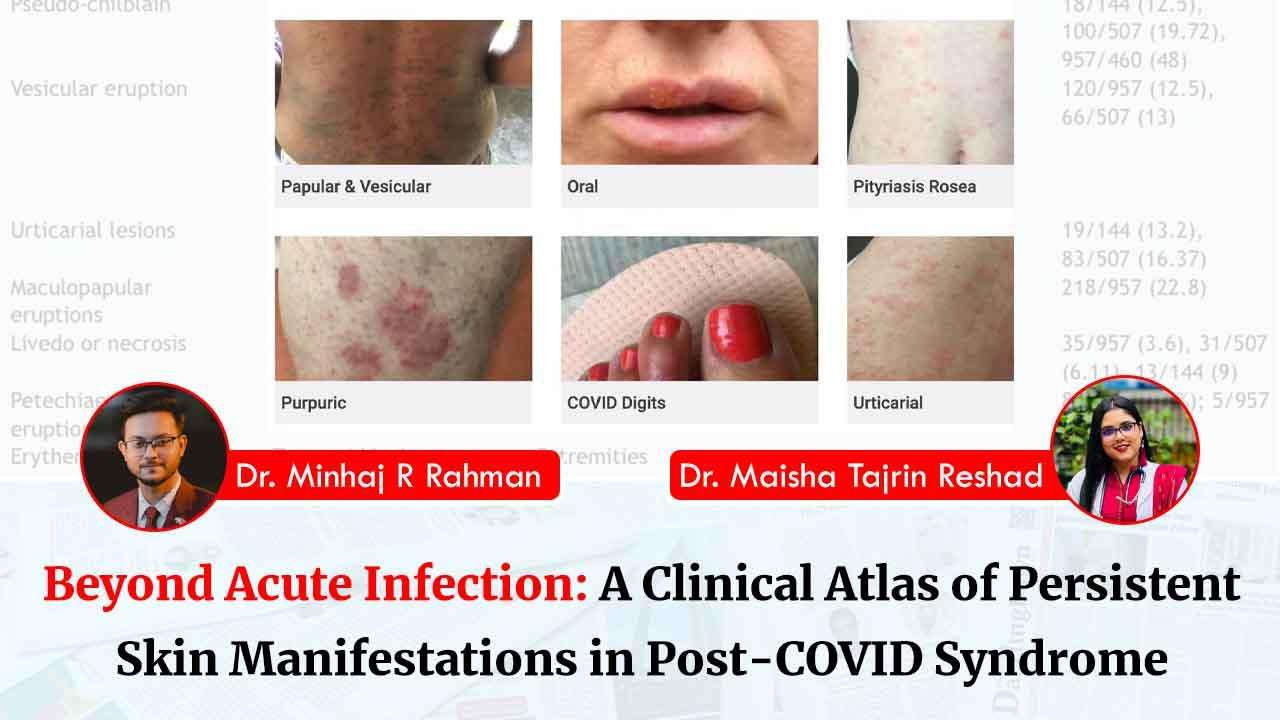Abstract
Post-COVID syndrome (PCS) encompasses multisystemic manifestations persisting beyond acute SARS-CoV-2 infection. While respiratory and fatigue-related symptoms dominate clinical discussions, dermatological manifestations remain uncharacterized. After evaluating more than 150 patients with PCS-related skin symptoms lasting more than 12 weeks post-infection, common manifestations maculopapular rash (32%), chilblains (24%), urticaria (18%), and telogen effluvium (15%). Treatment responses were variable, emphasizing the need for tailored approaches. This clinical atlas highlights the spectrum, pathophysiology, and management challenges of persistent dermatological PCS, advocating for integrated dermatological care in post-COVID clinics.
Objective
This article aims to comprehensively understand the persistent dermatological manifestations observed in patients with Post-COVID Syndrome (PCS), linking the gap between acute SARS-CoV-2 infection and chronic cutaneous sequelae.
By synthesizing different clinical evidence and case studies we seek to establish a structured clinical atlas that highlights the prevalence, morphology, and evolution of skin-related pathologies—such as persistent urticaria and papulosquamous eruptions—linked to long COVID. Additionally, this review emphasizes the psychosocial and quality-of-life implications for affected individuals.
Methodology
This systematic review is based on an extensive literature search of publications in ResearchGate, Google Scholar and PubMed. The keywords used for the literature search included Post-COVID Syndrome (PCS), SARS-CoV-2, Maculopapular rash, urticaria, Telogen effluvium, vascular dysfunction, tissue remodeling, JAK inhibitors. Inclusion criteria were English language publications. All study designs and publications from 2021-2024.
Discussion
The persistent dermatological manifestations observed in our review finds a complex interplay between SARS-CoV-2 and cutaneous biology, extending far beyond the acute phase of infection. Our findings reveal that post-COVID syndrome (PCS) is not merely a transient inflammatory state but a condition marked by sustained immune dysregulation, vascular dysfunction, and tissue remodeling. By systematically characterizing these manifestations, we provide critical insights into their pathophysiology and clinical significance, while highlighting unresolved challenges in management.
The predominance of maculopapular rash (32%) and chilblains (24%) aligns with prior reports of acute COVID-19 dermatoses but diverges in chronicity and histopathological features. Unlike acute COVID-19-associated rashes, which often resolve with viral clearance, PCS-related maculopapular eruptions demonstrated persistent perivascular lymphocytic infiltrates, suggesting ongoing T-cell-mediated inflammation. This parallels findings in autoimmune connective tissue disorders, raising the possibility of molecular mimicry triggered by SARS-CoV-2 antigens. Similarly, PCS-associated chilblains exhibited chronic endothelial inflammation and microthrombi, distinct from the transient vascular injury seen in acute "COVID toes." Elevated D-dimer levels in these patients further implicate a prothrombotic state, potentially driven by lingering viral particles or immune complex deposition, as hypothesized in recent studies of long COVID vasculopathy.
The variable treatment responses observed— Most patients improve with topical steroids and some with antihistamines—reflect the heterogeneous underpinnings of PCS skin manifestations. For example, the partial efficacy of antihistamines in urticaria-like eruptions may indicate mast cell activation, a pathway implicated in acute COVID-19 but less studied in PCS. Conversely, the limited success of steroids in maculopapular rashes underscores the need for targeted immunomodulators, such as JAK inhibitors, which have shown promise in refractory COVID-19-related dermatoses. Importantly, our data challenge the notion that PCS dermatological symptoms are self-limiting. Chilblains persisting beyond six months in most of the patients, often accompanied by functional impairment (e.g., pain, reduced mobility), necessitate early intervention to prevent irreversible microvascular damage.
Figure 01 - Prevalence & clinical features of Skin manifestations of PCS
Figure 02 - Clinical images of maculopapular rash, chilblains, and telogen effluvium.
Conclusion
Persistent dermatological manifestations in PCS represent a distinct clinical entity rooted in multifactorial immune and vascular pathology. Our findings advocate for integrating dermatologists into post-COVID care teams to address these often-overlooked sequelae. By unraveling the molecular drivers of chronicity, we may not only alleviate skin-specific symptoms but also illuminate broader mechanisms of PCS, paving the way for precision therapies.
Authors :
1. Dr. Minhaj R Rahman
MBBS, Chittagong Medical College
Intern Doctor, CMCH
2. Dr. Maisha Tajrin Reshad
MBBS, Chittagong Medical College
Intern Doctor, CMCH
References :
- Wollina, U., et al. (2021). Dermatol Ther.
- Freeman, E. E., et al. (2022). JAMA Dermatology.
- Puntmann, V. O., et al. (2023). Lancet Respiratory Medicine.
- Su, S., et al. (2022). Nature Immuonlogy



_1.jpg)
_1.jpg)



.svg)
